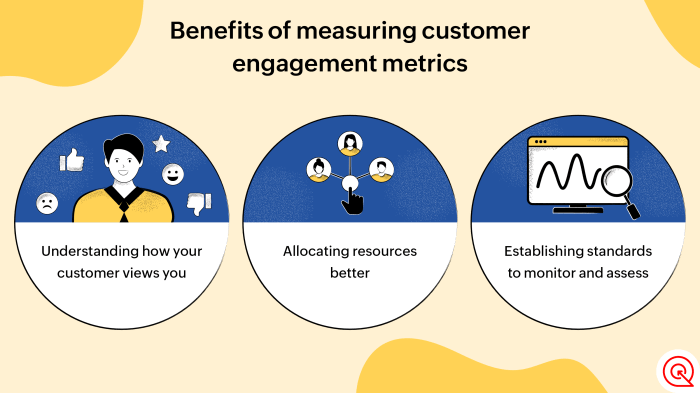Understanding Content Engagement Metrics sets the stage for diving deep into the world of digital marketing analytics. Get ready to uncover the secrets behind audience engagement and optimization strategies in this exciting journey.
From the importance of metrics to tools for monitoring and strategies for improvement, this topic is packed with valuable information to elevate your content game.
Importance of Content Engagement Metrics

Content engagement metrics play a vital role in shaping digital marketing strategies by providing insights into how audiences interact with content. These metrics help marketers understand the effectiveness of their campaigns, identify areas for improvement, and make data-driven decisions for better engagement.
Examples of Key Engagement Metrics
- 1. Click-Through Rate (CTR): This metric measures the percentage of users who click on a specific link or call-to-action within a piece of content. A high CTR indicates that the content is compelling and relevant to the audience.
- 2. Bounce Rate: Bounce rate shows the percentage of visitors who navigate away from a website after viewing only one page. A high bounce rate could signal that the content is not engaging enough or that the website needs improvements in user experience.
- 3. Time on Page: This metric tracks the average amount of time visitors spend on a webpage. A longer time on page suggests that the content is holding the audience’s attention and providing value.
How Understanding Metrics Optimizes Content
Understanding these metrics helps marketers tailor their content to meet the preferences and needs of their target audience. By analyzing engagement data, marketers can create more personalized and relevant content that resonates with users, ultimately leading to increased engagement, conversions, and brand loyalty.
Types of Content Engagement Metrics: Understanding Content Engagement Metrics
When it comes to measuring the success of your content, there are various types of engagement metrics that can provide valuable insights into your audience’s behavior and preferences.
Likes
Likes are a quantitative engagement metric that indicates how many people have shown appreciation for your content by clicking the like button. It gives a quick snapshot of how well-received your content is and can help gauge overall popularity.
Shares
Shares are another quantitative metric that shows how many times your content has been shared on social media platforms. This metric indicates how engaging your content is and how far its reach extends beyond your immediate audience.
Comments
Comments are a qualitative engagement metric that provides valuable feedback from your audience. They can give you insights into what resonates with your audience, what improvements can be made, and help foster a sense of community around your content.
Bounce Rate
Bounce rate is a quantitative metric that measures the percentage of visitors who navigate away from your site after viewing only one page. A high bounce rate could indicate that your content is not engaging enough or that it is not meeting the expectations of your audience.
Quantitative vs. Qualitative Engagement Metrics, Understanding Content Engagement Metrics
Quantitative metrics, such as likes, shares, and bounce rate, provide numerical data that can be easily measured and compared. Qualitative metrics, like comments, offer more nuanced insights into audience sentiment and preferences.
Each type of metric plays a crucial role in evaluating the performance of your content. Quantitative metrics give you a high-level overview of engagement levels, while qualitative metrics offer deeper insights into audience interactions and perceptions. By analyzing both types of metrics, you can gain a comprehensive understanding of how your content is resonating with your audience and make informed decisions to optimize future content strategies.
Tools for Monitoring Content Engagement
Monitoring content engagement is crucial for understanding how your audience interacts with your content. There are several popular tools available that can help track and analyze content engagement metrics.
Google Analytics
Google Analytics is a powerful tool that provides detailed insights into the performance of your content. It can track metrics such as page views, bounce rate, time on page, and conversion rate. By analyzing this data, you can understand which content resonates most with your audience and make informed decisions to optimize your content strategy.
BuzzSumo
BuzzSumo is another valuable tool for monitoring content engagement. It allows you to analyze the performance of your content across various social media platforms. You can track metrics such as social shares, likes, and comments to gauge the impact of your content. This information can help you identify trends and create content that drives more engagement.
SEMrush
SEMrush is a comprehensive tool that provides insights into both your content performance and your competitors’. It can help you identify s that drive traffic, analyze backlinks, and track social media engagement. By leveraging SEMrush, you can improve your content strategy and stay ahead of the competition.
Strategies to Improve Content Engagement

When it comes to boosting content engagement, analyzing metrics is just the first step. Taking actionable measures based on this analysis is crucial for achieving higher engagement rates.
Utilize A/B Testing
A/B testing involves creating two different versions of your content and testing them with your audience to see which one performs better in terms of engagement metrics. By analyzing the results of these tests, you can optimize your content for higher engagement.
For example, by experimenting with different headlines, images, or calls-to-action, you can identify what resonates best with your audience and tailor your content accordingly.
Implement Personalization Strategies
- Create personalized content based on user preferences and behaviors.
- Use dynamic content to deliver customized experiences to your audience.
- Segment your audience and tailor content to specific groups for increased engagement.
Leverage User-Generated Content
- Encourage users to create and share their own content related to your brand or products.
- Showcase user-generated content on your platforms to foster a sense of community and belonging.
- User-generated content is often more authentic and can significantly boost engagement levels.
Case Study: Company X
Company X implemented a user-generated content campaign where they invited customers to share their experiences with the brand on social media. This led to a 30% increase in engagement rates and generated a buzz around their products.












